Ryanair Holdings Bundle
How Does Ryanair Dominate the Skies?
Ryanair's journey from a small regional airline to Europe's largest carrier is a masterclass in strategic execution. Its success hinges on a powerful Ryanair Holdings SWOT Analysis, a laser focus on cost leadership, and a relentless pursuit of customer acquisition. Understanding the intricacies of Ryanair's sales and marketing strategy is key to appreciating its enduring competitive advantage.
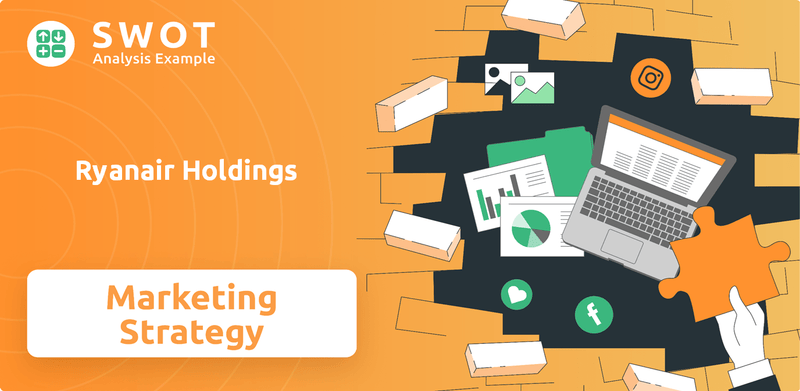
This exploration delves into Ryanair's innovative approach to the Ryanair sales strategy, dissecting its Ryanair marketing strategy and analyzing its impact on the airline industry. We'll examine the Ryanair business model, including its Ryanair marketing campaigns and Ryanair pricing strategy, to understand how Ryanair has consistently outperformed its rivals. Furthermore, we'll explore how Ryanair's digital marketing approach, social media presence, and data analytics contribute to its success in a highly competitive market.
How Does Ryanair Holdings Reach Its Customers?
The core of the Ryanair sales and marketing strategy revolves around its direct sales model, primarily through its website, Ryanair.com. This approach allows the airline to maintain control over the customer experience and minimize distribution costs. This direct-to-consumer (DTC) strategy is a key component of the Ryanair business model, enabling the airline to offer competitive prices and upsell ancillary services.
While Ryanair utilizes online travel agencies (OTAs) to some extent, it actively encourages customers to book directly through its website. This strategic focus on direct sales is aimed at maximizing revenue per passenger and reducing reliance on third-party platforms. The company continuously optimizes its website for user experience, mobile accessibility, and personalized offers to enhance the customer journey.
Ryanair's sales channels are designed to support its low-cost structure and drive profitability. The airline's approach to sales and marketing is a critical element of its overall success.
Ryanair.com is the primary sales channel, accounting for a significant portion of bookings. This direct-to-consumer model allows for control over the customer experience. The website is continually updated to improve user experience and offer personalized deals.
Ryanair utilizes OTAs, but actively encourages direct bookings. The airline aims to drive customers to its direct channels to maximize revenue. Ryanair often does not offer its full range of services or best prices through these channels.
Partnerships with airports, particularly secondary and regional airports, are crucial. These agreements provide lower landing fees and incentives. These partnerships help Ryanair expand its route network and maintain its low-cost model.
Self-service kiosks at terminals streamline check-in and baggage drop. This enhances the customer experience within the low-cost framework. The focus is on digital adoption and efficient direct booking.
Ryanair's sales strategy is heavily focused on direct bookings to control the customer journey and maximize revenue. This approach is supported by strategic partnerships and a streamlined airport presence. The Growth Strategy of Ryanair Holdings highlights the importance of these channels.
- Direct-to-consumer (DTC) model via Ryanair.com.
- Strategic partnerships with airports for route expansion.
- Emphasis on digital adoption and efficient booking processes.
- Minimizing reliance on third-party platforms.
Ryanair Holdings SWOT Analysis
- Complete SWOT Breakdown
- Fully Customizable
- Editable in Excel & Word
- Professional Formatting
- Investor-Ready Format
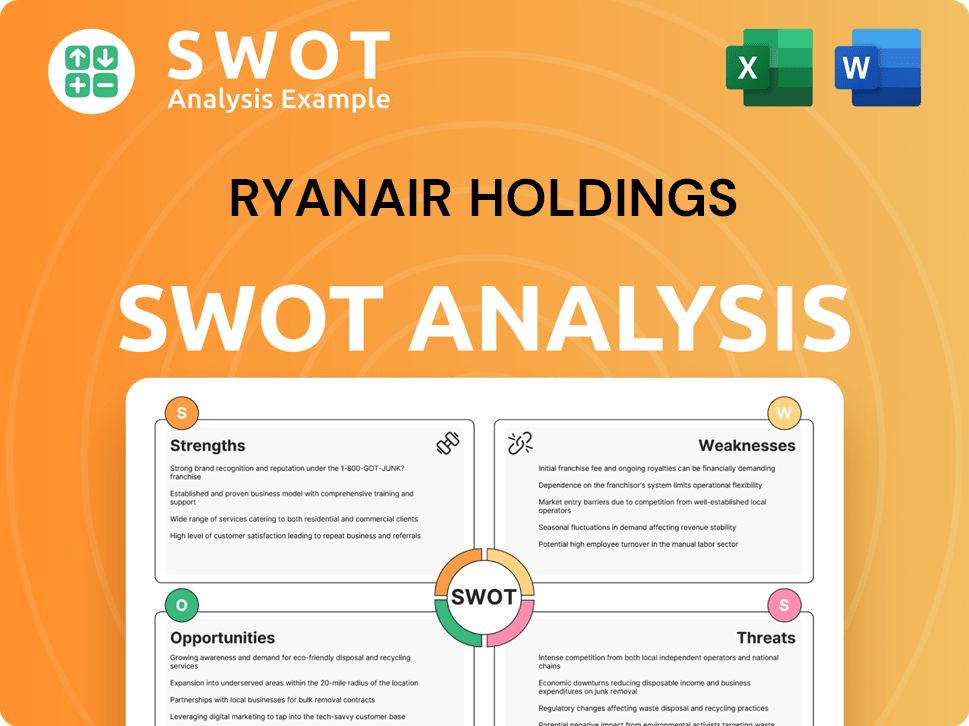
What Marketing Tactics Does Ryanair Holdings Use?
The marketing tactics of Ryanair are fundamentally intertwined with its low-cost business model, prioritizing high-volume sales through impactful campaigns and a robust digital presence. This strategy is designed to maximize customer acquisition and maintain a competitive edge in the airline industry. Their approach focuses on efficiency and cost-effectiveness, ensuring that marketing efforts directly contribute to revenue generation.
Digital channels are central to Ryanair's Ryanair marketing strategy, with a strong emphasis on paid advertising across search engines and social media platforms. Dynamic pricing, a key component of their Ryanair pricing strategy, is heavily promoted through their website and email marketing, encouraging immediate bookings. Traditional media is used to amplify key messages, but digital platforms are the primary drivers of lead generation.
Ryanair's marketing approach is data-driven, utilizing sophisticated revenue management systems to adjust fares based on demand, competitor pricing, and booking patterns. Customer segmentation is primarily based on price sensitivity, with targeted offers delivered via email and website personalization. The mobile app is a crucial tool for customer engagement, offering booking, check-in, and in-flight service options. This evolution from controversial print ads to a digitally focused strategy leverages its vast online customer base and real-time data to boost bookings.
Digital marketing is at the core of Ryanair's strategy, with a significant focus on paid advertising, particularly through search engine marketing (SEM) and social media. This approach enables the airline to target specific customer segments and optimize its advertising spend for maximum impact.
Ryanair employs dynamic pricing, adjusting fares based on demand, competitor pricing, and booking patterns. This strategy is heavily promoted through its website and email marketing campaigns to stimulate demand and fill seats.
The mobile app is a crucial tool for customer engagement, providing booking, check-in, and in-flight service options. This enhances customer experience and drives direct bookings, reducing reliance on third-party platforms.
Ryanair leverages data analytics and revenue management systems to optimize pricing and marketing efforts. This data-driven approach allows for real-time adjustments and targeted promotions.
Customer segmentation is primarily driven by price sensitivity, allowing for targeted offers delivered through email and website personalization. This ensures that the right offers reach the right customers.
Ryanair often generates press coverage through its outspoken CEO, Michael O'Leary, and avoids large-scale content marketing or influencer partnerships. This approach relies on strong brand recognition and frequent media mentions.
Ryanair's marketing strategy is a blend of aggressive pricing, digital focus, and data-driven decision-making. The airline's approach to market segmentation and revenue management is crucial for its Ryanair sales strategy.
- Digital Advertising: Ryanair invests heavily in paid advertising, particularly through search engine marketing (SEM) and social media.
- Dynamic Pricing: Fares are adjusted based on demand, competitor pricing, and booking patterns, often promoted through email marketing.
- Mobile App: The mobile app is a key tool for customer engagement, providing booking, check-in, and in-flight service options.
- Customer Segmentation: Targeted offers are delivered through email and website personalization based on price sensitivity.
- Revenue Management: Sophisticated systems dynamically adjust fares to maximize revenue.
- Brand Reputation: The brand relies on strong recognition and frequent press coverage.
For more detailed insights into the financial performance and ownership structure, consider exploring the information available about Owners & Shareholders of Ryanair Holdings.
Ryanair Holdings PESTLE Analysis
- Covers All 6 PESTLE Categories
- No Research Needed – Save Hours of Work
- Built by Experts, Trusted by Consultants
- Instant Download, Ready to Use
- 100% Editable, Fully Customizable
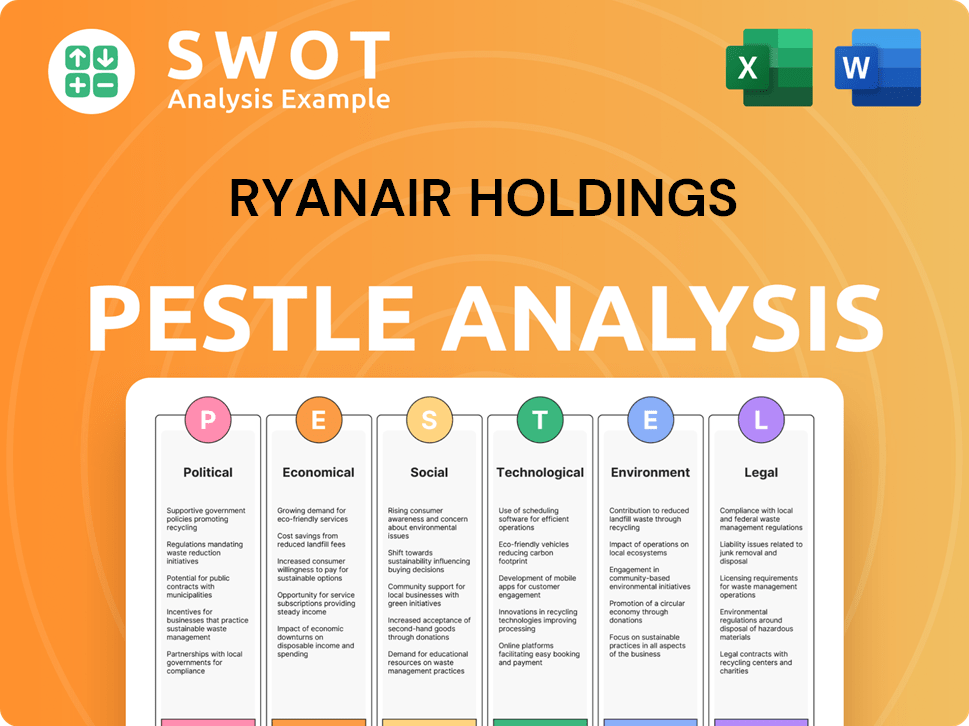
How Is Ryanair Holdings Positioned in the Market?
The brand positioning of Ryanair is centered on value and affordability, establishing itself as Europe's leading ultra-low-cost carrier. Its core message focuses on offering the lowest fares, thereby making air travel accessible to a wide audience. The visual identity is characterized by a straightforward blue and yellow color scheme. Ryanair's communication style is often direct and unapologetic, reflecting its no-frills approach.
The customer experience is designed for efficiency and functionality, prioritizing on-time performance and reliability over luxury amenities. Ryanair's target audience is broad, encompassing budget-conscious travelers such as leisure travelers, students, and business travelers seeking cost-effective solutions. The airline's target market is clearly defined, focusing on those who prioritize price above all else.
The company has recently focused on improving customer service and addressing past criticisms, which is part of a broader strategy to enhance brand perception and foster customer loyalty. Initiatives like the 'Always Getting Better' program demonstrate this shift. Ryanair aims for brand consistency across all touchpoints, reinforcing its low-cost, efficient message. The airline consistently monitors consumer sentiment and responds to competitive threats by emphasizing its commitment to low fares and expanding its network, often highlighting its superior punctuality and reduced cancellations compared to competitors.
Ryanair's primary message revolves around providing the lowest fares in the market. This strategy aims to make air travel affordable for a wide range of customers. The focus is on value, ensuring cost-effectiveness remains the top priority.
The airline uses a distinctive blue and yellow color scheme to maintain brand recognition. This straightforward approach helps in easily identifying the brand across different platforms. The visual consistency reinforces the brand's identity.
The customer experience is designed for efficiency, with a focus on on-time performance. Ryanair prioritizes reliability and functionality over luxury. This approach aligns with its low-cost model.
Ryanair targets budget-conscious travelers, including leisure and business travelers. The airline's strategy appeals to those who prioritize affordability when making travel decisions. This broad appeal helps drive sales.
Ryanair has been working on improving customer service and addressing past criticisms. This includes initiatives like the 'Always Getting Better' program. These efforts aim to enhance brand perception and customer loyalty.
- Focus on customer service improvements.
- Addressing past criticisms related to fees.
- Enhancing brand perception.
- Fostering greater customer loyalty.
Ryanair Holdings Business Model Canvas
- Complete 9-Block Business Model Canvas
- Effortlessly Communicate Your Business Strategy
- Investor-Ready BMC Format
- 100% Editable and Customizable
- Clear and Structured Layout
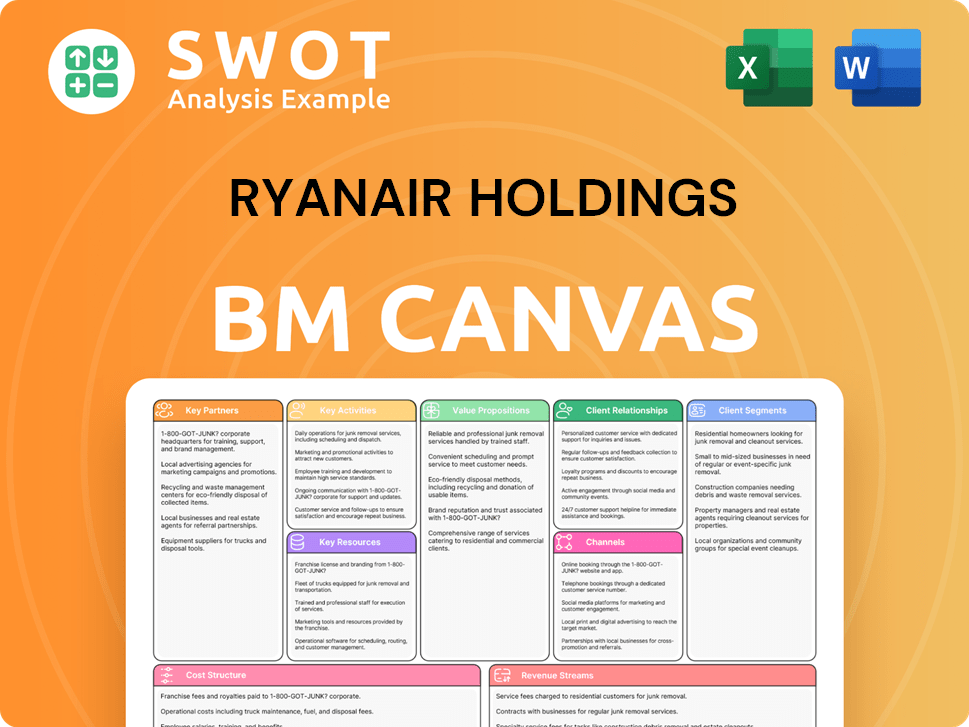
What Are Ryanair Holdings’s Most Notable Campaigns?
The Growth Strategy of Ryanair Holdings has been consistently shaped by impactful marketing campaigns designed to drive sales and reinforce its brand positioning within the competitive airline industry. These campaigns have evolved over time, adapting to changing market dynamics and customer expectations while always aiming to maximize passenger numbers and market share. The core of Ryanair's strategy has been to offer low fares and this has been consistently communicated through its marketing efforts.
Historically, Ryanair's marketing strategy focused on emphasizing its 'no frills' approach, directly challenging traditional airlines. This strategy was primarily executed through print media and its website, educating consumers about its unbundled fare structure. This approach aimed to solidify its image as the cheapest option. More recently, Ryanair has expanded its marketing efforts to highlight improved customer service and a wider route network, adapting to changing customer expectations and the competitive landscape. The company's digital marketing approach has also become increasingly sophisticated.
Ryanair's marketing campaigns are pivotal in its overall sales strategy. By understanding the evolution of these campaigns, one can gain insights into Ryanair's approach to market segmentation, its customer acquisition strategy, and its ability to maintain a competitive advantage in the aviation industry. These campaigns are crucial for driving bookings, building brand loyalty, and adapting to the ever-changing demands of the travel market.
In the early 2000s, Ryanair's marketing strategy heavily emphasized its 'no frills' approach. Campaigns highlighted the cost savings of flying with Ryanair compared to traditional airlines. These campaigns were primarily executed through print media and its website, focusing on educating consumers about its unbundled fare structure.
Launched in 2014, this multi-year initiative aimed to improve the customer experience. It included introducing allocated seating, a second free carry-on bag, and reduced rebooking fees. This campaign was communicated through digital channels, press releases, and in-flight announcements.
Ryanair frequently runs tactical campaigns tied to seasonal demand or new route launches. These campaigns are heavily promoted through its website and email newsletters. They offer flash sales and limited-time discounts to stimulate immediate bookings and drive sales.
Ryanair has increased its focus on digital marketing, using its website and social media platforms to reach potential customers. Data analytics plays a crucial role in these efforts, helping to personalize offers and target specific demographics. This is an important part of their Ryanair marketing strategy.
The primary objectives of Ryanair's marketing campaigns are to increase passenger numbers, expand market share, and enhance brand perception. The 'no frills' campaign successfully established Ryanair as a low-cost leader, while the 'Always Getting Better' program aimed to improve customer satisfaction and foster loyalty. Tactical campaigns are designed to boost immediate bookings and manage revenue effectively.
- Passenger Growth: Ryanair's passenger numbers have shown consistent growth. In 2023, Ryanair carried over 180 million passengers, demonstrating the effectiveness of its marketing and sales strategies.
- Market Share: Ryanair has a significant market share in the European aviation market. Their campaigns have contributed to maintaining and growing their share, competing effectively with both low-cost and traditional airlines.
- Customer Satisfaction: The 'Always Getting Better' program has shown improvements in customer satisfaction scores, indicating the success of efforts to enhance the overall customer experience. This is a key element of Ryanair's customer acquisition strategy.
- Revenue: Ryanair's revenue management strategies, including flash sales and promotional offers, have played a role in optimizing revenue. In the fiscal year 2024, Ryanair reported a strong financial performance, with increased revenue figures.
Ryanair Holdings Porter's Five Forces Analysis
- Covers All 5 Competitive Forces in Detail
- Structured for Consultants, Students, and Founders
- 100% Editable in Microsoft Word & Excel
- Instant Digital Download – Use Immediately
- Compatible with Mac & PC – Fully Unlocked
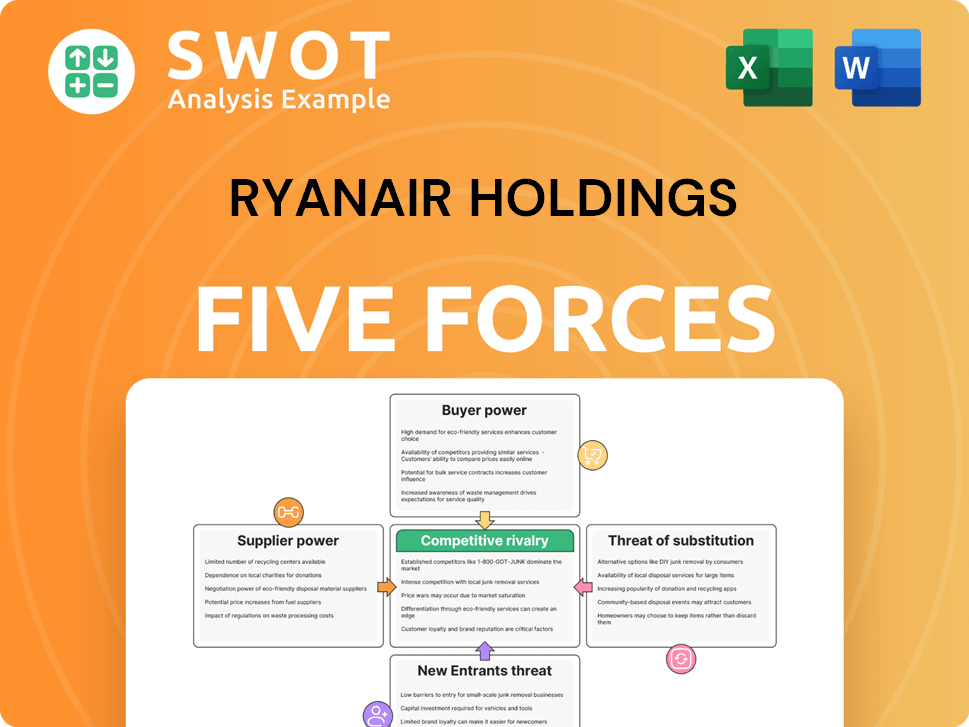
Related Blogs
- What are Mission Vision & Core Values of Ryanair Holdings Company?
- What is Competitive Landscape of Ryanair Holdings Company?
- What is Growth Strategy and Future Prospects of Ryanair Holdings Company?
- How Does Ryanair Holdings Company Work?
- What is Brief History of Ryanair Holdings Company?
- Who Owns Ryanair Holdings Company?
- What is Customer Demographics and Target Market of Ryanair Holdings Company?
Disclaimer
All information, articles, and product details provided on this website are for general informational and educational purposes only. We do not claim any ownership over, nor do we intend to infringe upon, any trademarks, copyrights, logos, brand names, or other intellectual property mentioned or depicted on this site. Such intellectual property remains the property of its respective owners, and any references here are made solely for identification or informational purposes, without implying any affiliation, endorsement, or partnership.
We make no representations or warranties, express or implied, regarding the accuracy, completeness, or suitability of any content or products presented. Nothing on this website should be construed as legal, tax, investment, financial, medical, or other professional advice. In addition, no part of this site—including articles or product references—constitutes a solicitation, recommendation, endorsement, advertisement, or offer to buy or sell any securities, franchises, or other financial instruments, particularly in jurisdictions where such activity would be unlawful.
All content is of a general nature and may not address the specific circumstances of any individual or entity. It is not a substitute for professional advice or services. Any actions you take based on the information provided here are strictly at your own risk. You accept full responsibility for any decisions or outcomes arising from your use of this website and agree to release us from any liability in connection with your use of, or reliance upon, the content or products found herein.